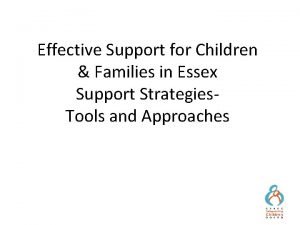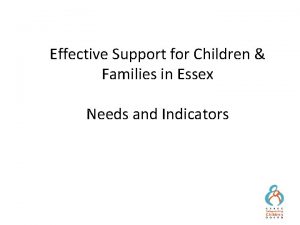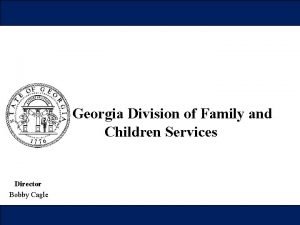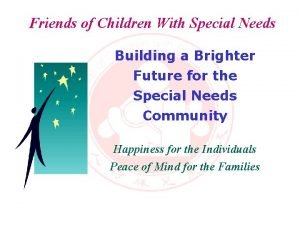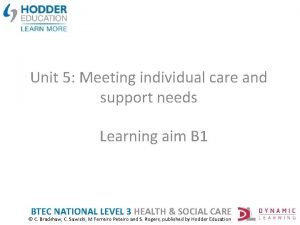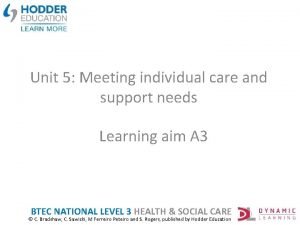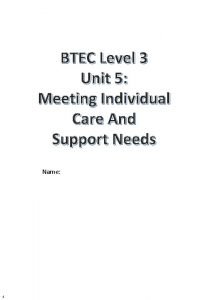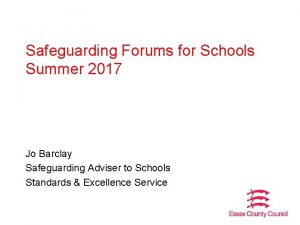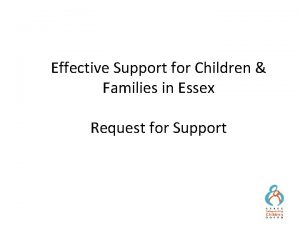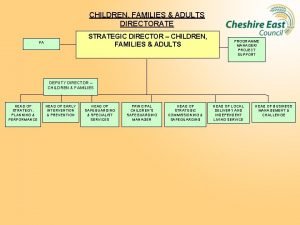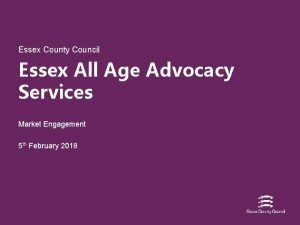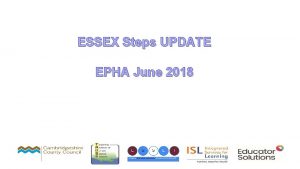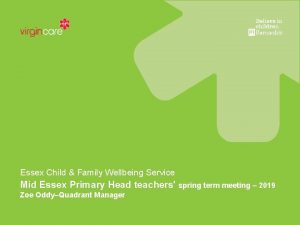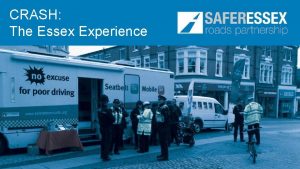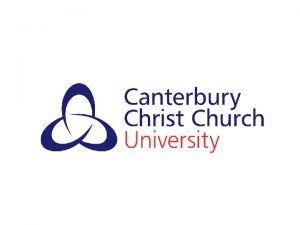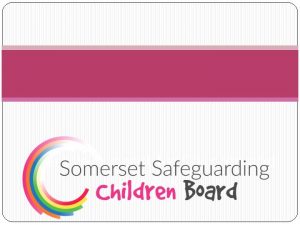Effective Support for Children Families in Essex Needs

















- Slides: 17

Effective Support for Children & Families in Essex Needs and Indicators 1

Effective Support for Children & Families in Essex (Guidance) • This guidance is for everyone who works with children and young people and their families in Essex. • “In Essex we all believe that every child should have the opportunity to reach their full potential and that children are best supported to grow and achieve within their own families. • By working together, we will develop flexible services which are responsive to children’s and families’ needs and provide the right level of intervention at the right time. ” 2

Effective Support for Children & Families in Essex • It is about the way we can all work together, share information and put the child and their family at the centre, providing effective support to help them solve problems and find solutions at an early stage to prevent problems escalating • There may be times when the needs of the family are such that intensive or specialist statutory intervention is required • The aim is always to both build resilience in children and families and the capacity to overcome their own difficulties, for the remainder of their lives. • There are 4 levels Universal, Additional, Intensive and Specialist. 3


Effective Support Guidance & Support Windscreen – Level 1 Universal 5

Effective Support Guidance & Support Windscreen – Level 1 Universal Level & Referral Routes - Universal open access to provision Needs All children and families who live in the area have core needs such as parenting, health and education. Services (examples) Early years, education, primary health care, maternity services, housing, community health care, youth centres, leisure services. Children are supported by their family and in universal services to meet all of their needs Outcomes Children and young people make good progress in most areas of development 6

Effective Support Guidance & Support Windscreen – Level 1 Universal Indicator: • Children and young people who make good overall progress in most areas of development • Receive appropriate universal services, such as health care and education. • They may also use leisure and play facilities, housing or voluntary sector services. 7

Effective Support Guidance & Support Windscreen – Level 2 Additional

Level 2 Additional Level & Referral Routes -Additional One or more services provide voluntary additional support to meet the child and family needs. This is co-ordinated by a service that knows the child/family best. An Early Help Plan and Team Around the Family meeting is helpful to bring the family and involved services together to share information and agree what would be helpful. Individual agency internal routes to access additional supports or to request external services Needs Children and families with additional needs who would benefit from or who require extra help to: Improve education; improve parenting and/or behaviour; meet specific health or emotional needs of the child and/or parent; improve their material situation; respond to a short term crisis such as bereavement; parental separation Services (examples) Parenting support; commissioned early help services; school holiday and short breaks provision for disabled children; extra health support for family members; behavioural support; housing support; additional learning support; Special Education Needs (SEN) Support plan; help to find education and employment; emotional Wellbeing Mental Health Service support to schools; speech and Language therapy; family hubs; targeted youth work; Services provided on a voluntary basis Outcomes The life chances of children and families are improved by offering early life and early help additional support. 9

Effective Support Guidance & Support Windscreen – Level 2 Additional Indicators : • Children and young people whose needs require some extra support. • A single universal or targeted service or two services are likely to be involved; these services should work together. • A Team Around the Family meeting to share information and agree an Early Help • Plan to support the child and family is helpful. • No need for specialist services.

Effective Support Guidance & Support Windscreen – Level 3 Intensive 11

Level 3 Intensive Level & Referral Routes -Level 3 Intensive A multi-disciplinary / agency Team Around the Family (TAF), led by a Lead Practitioner, shares information and co-ordinates intensive services and support to meet the child and family needs. An Early Help Plan / Shared Family Assessment Family is necessary to set out how the family and involved services will work together to meet the child’s needs. Individual agency internal routes to access intensive supports or Children & Families Request for Support form (RFS) to access Family Solutions. Needs Vulnerable children and their families with multiple needs or whose needs are more complex, such as children and families who: have a disability; resulting in complex needs; Exhibit anti-social or challenging behaviour; suffer neglect or poor family relationships; have poor engagement with key services such as school and health; are not in education or work long-term Services (examples) Because of the complexity of needs, especially around behaviour and parenting, a multidisciplinary/ agency co-ordinated plan developed with the family is needed, coordinated by a Lead Practitioner or family (key) worker. A wide range of services providing additional and intensive intervention might be involved in meeting the family’s needs. Families needing substantial support to care for a disabled child. Services provided on a voluntary basis. Outcomes Vulnerable children and families likely to face impairment to their development and life chances will be supported by services to enable them to achieve. Issues will be prevented from escalating into safeguarding concerns requiring statutory intervention. 12

Effective Support Guidance & Support Windscreen – Level 3 Intensive Indicators: • A number of indicators would need to be present with more than one service involved • Team Around the Family, Early Help Plan/Shared Family Assessment approach required. • Family Solutions can support at this level 13

Effective Support Guidance & Support Windscreen – Level 4 Specialist 14

Level 4 - Specialist Level & Referral Routes - Level 4 Specialist Children`s Social Care, Child Protection Care Proceedings, Youth Treatment Orders/ Custody Hospital in- patient; Children & Families Request for Support (RFS); Statutory notifications to Youth Offending Service; Statutory health assessments Needs Children and young people who have suffered or are likely to suffer significant harm as a result of abuse or neglect; Children with significant impairment of function/learning and/or life limiting illness; Children whose parents and wider family are unable to care for them; Families involved in crime/misuse of drugs at a significant level; Families with significant mental or physical health needs Services (examples) Children’s Social Care; Youth Offending Service; Criminal Justice system; Emotional Wellbeing and Mental Health Service; In patient and continuing health care; Fostering and residential care ; Health care for children with life limiting illness; Services for children with profound and enduring disability Outcomes Children and /or family members are likely to suffer significant harm/ removal from home/ serious and lasting impairment without the intervention of specialist services, sometimes in a statutory role. 15

Effective Support Guidance & Support Windscreen – Level 4 Specialist Indicator(s): • Children and young people whose needs are complex and enduring and cross many domains. • More than one service is normally involved, with a co-ordinated multi-agency approach and a Lead Practitioner, commonly in a non-statutory role. • At times statutory intervention may be required 16

Activity • Using the level descriptors from the Effective Support Document, look at the case study and decide at what level they are best placed. • Discuss in your groups: – What discussions do you need to have and with who? – What level of service do you think the family need – Why you think they are at this level? 17
 Effective support for children and families in essex
Effective support for children and families in essex Effective support for families in essex
Effective support for families in essex Families in focus essex
Families in focus essex Unit 18 assessing children's development support needs p1
Unit 18 assessing children's development support needs p1 Little families
Little families Georgia department of children and families
Georgia department of children and families The needs of families and suitability for the local
The needs of families and suitability for the local Friends of children with special needs
Friends of children with special needs Primary needs and secondary needs
Primary needs and secondary needs Simple claustral complex
Simple claustral complex Strategic gender needs and practical gender needs
Strategic gender needs and practical gender needs Primary needs and secondary needs
Primary needs and secondary needs Learning situation analysis
Learning situation analysis Unit 5: meeting individual care and support needs
Unit 5: meeting individual care and support needs Martin hoffman empathy theory health and social care
Martin hoffman empathy theory health and social care Unit 5 health and social care coursework example p3
Unit 5 health and social care coursework example p3 Example of major points
Example of major points Jo barclay essex safeguarding
Jo barclay essex safeguarding
